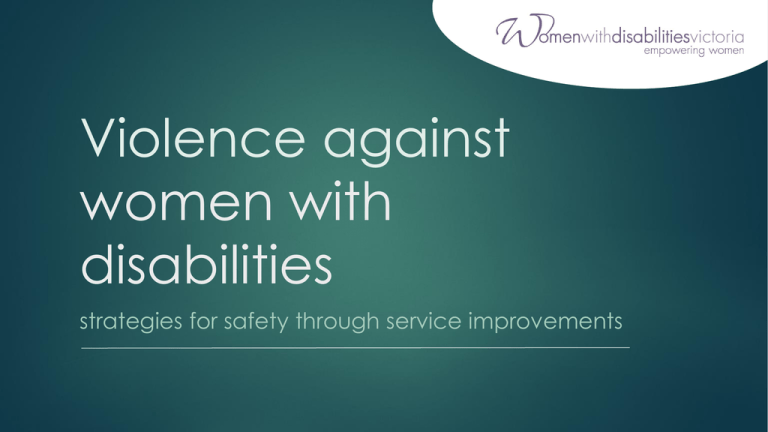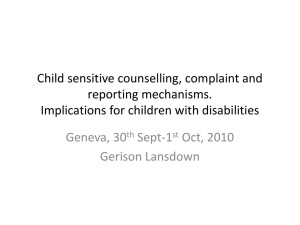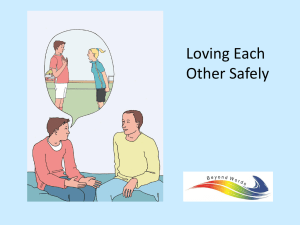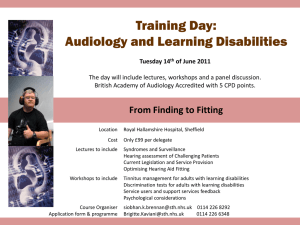
Violence against
women with
disabilities
strategies for safety through service improvements
Introduction
Worldwide, women experience high rates of violence
and sexual assault.
While rates of STIs spread through assault are difficult
to measure, we know it is a significant risk.
After experiencing assault there are barriers to
reporting, seeking support & treatment.
Pakistani women protest against the abuse of women's rights at a
rally to mark International Women's Day in Karachi. Photograph: Asif
Hassan/AFP/Getty
THE GAP REPORT
This month UNAIDS (July 2014) reported:
• Women and girls with disabilities experience all the risk
factors for acquiring HIV.
• They are at higher risk of sexual violence than other
women.
• This is a significant public health & human rights issue. 0
0. http://www.unaids.org/en/media/unaids/contentassets/documents/unaidspublication/2014/UNAIDS_Gap_report_en.pdf
This presentation will cover:
• Prevalence of violence against women with
disabilities in Victoria
• Good practice examples of strategies for
safety
The Voices Against Violence Project (2014)
did a review of women with disabilities’ files
at the Office of the Public
Advocate.
The review found that:
• 45 of 100 women reported experiencing
violence
• These 45 women experienced violence at the
hands of a total of 89 perpetrators1
This research can be seen at www.wdv.org.au
1. McGuire, Magdalena, 2014, Voices Against Violence, Women with Disabilities Victoria.
Voices against violence
The Victorian Mental Illness Awareness Council found:
• 45% of women experienced sexual assault during
a mental health hospital admission
• 67% of women reported experiencing harassment
during mental health hospitalisation
• more than 80% lived in fear of
being abused3
3. VMIAC, 2013, ‘Zero Tolerance for Sexual Assault: A safe admission for women.’
“I can’t use the phone. There was no way for me to tell anybody.”
“everybody looked up to him...
“The staff did nothing.”
“They would take my kids.”
“No one believed me.”
“They didn’t
know how to
“For years they put my behaviour down to
communicate
attention seeking because of my disability.
with me
Finally my doctor opened his bloody ears and
“Police said
there was no heard what I was trying to say.”
point taking it
any further.”
“He kept saying it was
my fault, and over time,
I grew to believe him.”
“It wasn’t until years
later I found out it was
a crime.”
…no
“People with commination difficulties need longer appointment times.”
independent
“The Police said it was my transport.”
“He said if I told anybody he
fault, that I shouldn’t have
would put me in a home.” let the taxi driver in.”
“He told them I was crazy. They believed him”
…no interpreter.”
Governments and services must be informed of their
responsibility to uphold human rights
to safety and justice.
So I would like to share some strategies for safety
through 4 examples of good practice.
Convention on
the elimination of
all forms of
discrimination
against women
# 1: accessible response services
“Making Rights Reality” enhances existing services
at a Sexual Assault Centre and a Legal Centre to
create better access for people with
speech impairments and
intellectual disabilities.
Staff developed skills working with clients with
little or no speech.
Some clients use
‘communication boards’ to
point at what they want to
say.
Most other services are
inaccessible to them.
“Making Rights Reality” created a series of sexual assault
information sheets in ‘Easy English’ for people with
intellectual disabilities.
You can see these by
visiting their website.
http://www.secasa.com.au
Hopefully in the near future we can be sharing
good practice examples of working with men
who choose to sexually assault women with
disabilities.
# 2: inclusive policy
In response to sustained advocacy, the
Victorian Government and Police at
times consult with women with disabilities
when developing policies, plans &
guidelines.
As a result, key documents include
specific strategies for women with
disabilities.
Sexual assault reform
strategy 2006
Family Violence
Protection Act 2008
Victoria Police Code
of Practice for the
Investigation of
Family Violence 2014
Personal Safety Act
2010
Victoria’s action plan to
address violence against
women and their
children 2012
Victorian Disability
State Plan 2012
# 3: prevention The Barwon Centre Against Sexual
Assault runs a sexual assault and education prevention
programs in schools.
They realised that, systemically, kids with disabilities are left
out of education about safe sex and healthy relationships.
They tailored a program for children with disabilities in a
Special Developmental School.
They took a whole of school approach,
involving all staff across the school.
# 4: workforce development
Disability services workers usually do not receive any
violence against women awareness training.
To address this gap, Women with disabilities Victoria
are delivering a workforce development program on
Gender and Disability. The program covers:
• recognising
• responding
• and preventing
violence against women with disabilities.
The program is informed by the understanding
that people who choose to use violence against
women with disabilities tend to believe in:
• rigid gender roles
• male entitlement
• and target victims they see as less powerful 4
The program challenges these attitudes and
behaviours.
4. Brownridge, D A, 2009, Violence Against Women: Vulnerable Populations, New York, Routledge.
Brownridge, D A, 2006, ‘Partner Violence Against Women With Disabilities: Prevalence, Risk and Explanation’, Violence Against
Women, 12
The practice examples shared don’t
require lots of money.
They are about
• changing attitudes
• sectors working together
• listening to women with disabilities
Thank you
To find out more about our research and projects
visit www.wdv.org.au
“Go to a… women’s organisation (or someone you
can trust) that is likely to believe you. ‘Cause that’s
the first thing you want... There’s nothing worse
than going to somebody and they don’t believe
you, and then you often stop there and you don’t
follow it through.
The other thing for people with disabilities, be
strong in yourself and know that what you’re
feeling, if it’s feeling wrong, then it is wrong.”
Michelle









